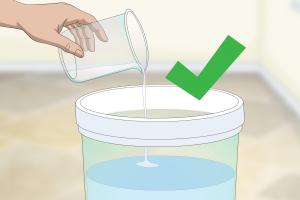DIY Guide to Making Your Own Homemade Paint Thinner

-
Quick Links:
- Introduction
- What is Paint Thinner?
- Why Make Homemade Paint Thinner?
- Ingredients Needed
- Step-by-Step Guide to Making Paint Thinner
- Safety Tips
- Common Uses for Paint Thinner
- Case Studies & Examples
- Expert Insights
- FAQs
Introduction
Painting projects can often lead to the need for paint thinner, a versatile solvent used to thin paint, clean brushes, and remove excess paint from surfaces. While commercial paint thinners are readily available, making your own at home can save money, reduce chemical exposure, and allow for customization based on your preferences. This guide will walk you through the entire process of creating your homemade paint thinner, exploring its benefits, safety tips, and practical applications.
What is Paint Thinner?
Paint thinner is a solvent primarily used to dilute oil-based paints and coatings. It is a mixture of different chemicals that can vary by brand. Common ingredients include mineral spirits, acetone, turpentine, and various petroleum distillates. Each component serves a specific function, enhancing the paint's workability and finish.
Why Make Homemade Paint Thinner?
- Cost-Effective: Homemade solutions can be significantly cheaper than store-bought options.
- Eco-Friendly: By using natural ingredients, you can avoid harmful chemicals.
- Customization: Tailor the thinner to your specific needs by adjusting the ingredients.
- Availability: You may already have some ingredients at home, making it convenient.
Ingredients Needed
To make your homemade paint thinner, you'll need the following ingredients:
- Vegetable Oil: Acts as a base and is a safe alternative to petroleum-based products.
- Alcohol: Isopropyl alcohol or rubbing alcohol can enhance the thinning process.
- Essential Oils: Optional, for fragrance and additional cleaning properties (e.g., lemon or eucalyptus oil).
Step-by-Step Guide to Making Paint Thinner
Method 1: Basic Vegetable Oil Thinner
- Gather your ingredients: 1 part vegetable oil and 1 part isopropyl alcohol.
- In a mixing bowl, combine the vegetable oil and alcohol. Stir well until fully blended.
- Store in a tightly sealed container, labeled with the date and contents.
- Shake before use.
Method 2: Essential Oil Infused Thinner
- Prepare 1 part vegetable oil, 1 part isopropyl alcohol, and a few drops of your chosen essential oil.
- Mix the oil, alcohol, and essential oil in a bowl.
- Transfer the mixture into a sealed container and label it.
Safety Tips
While making and using homemade paint thinner, consider the following safety precautions:
- Always work in a well-ventilated area to avoid inhaling fumes.
- Wear gloves to protect your skin from irritation.
- Keep the thinner away from heat sources and open flames, as some ingredients are flammable.
- Store the thinner in a cool, dry place, out of reach of children and pets.
Common Uses for Paint Thinner
Homemade paint thinner can be used for various purposes, including:
- Thinning oil-based paints for smoother application.
- Cleaning paintbrushes and tools after painting.
- Removing paint spills or stains from surfaces.
Case Studies & Examples
Recently, a DIY enthusiast shared their experience of using homemade paint thinner for a large mural project. The individual mixed vegetable oil with isopropyl alcohol and added a few drops of lavender essential oil for a pleasant scent. The result was a smooth application and easy clean-up, demonstrating the practical effectiveness of homemade solutions.
Expert Insights
Experts in the field of home improvement suggest that homemade paint thinner can be just as effective as commercial products when made correctly. They recommend experimenting with ratios and ingredients to find the perfect blend for your specific needs. Additionally, utilizing non-toxic ingredients aligns with the growing trend of eco-friendly home improvement.
FAQs
1. What is the best substitute for paint thinner?
Vegetable oil and isopropyl alcohol make an excellent substitute for traditional paint thinner.
2. Can I use vinegar as a paint thinner?
Vinegar is not recommended as a paint thinner as it does not effectively dissolve paint. However, it can clean brushes.
3. Is homemade paint thinner safe for the environment?
Yes, if made with natural ingredients, homemade paint thinner can be more environmentally friendly than commercial options.
4. How do I clean up spills from homemade paint thinner?
Use paper towels to absorb the thinner and clean the area with soap and water afterward.
5. Can I use homemade paint thinner on water-based paints?
No, homemade paint thinner is primarily for oil-based paints. Use water for thinning water-based paints.
6. How long does homemade paint thinner last?
When stored properly in a sealed container, it can last for several months.
7. Can I mix different types of oils for paint thinner?
Yes, you can experiment with different oils to achieve the desired consistency and properties.
8. Is it safe to dispose of homemade paint thinner down the sink?
It is not advisable to dispose of any paint thinners, homemade or otherwise, down the sink. Check local regulations for proper disposal methods.
9. Can I use essential oils in paint thinner for fragrance?
Yes, essential oils can be added for fragrance and additional cleaning properties.
10. Where can I find more information about eco-friendly painting?
For more information, visit the EPA Safer Choice website for guidelines on eco-friendly products and practices.
Random Reads
- How to print part of an excel spreadsheet
- How to print posters
- Unlocking sixth builder clash of clans
- Unlocking secure boot
- How to remove default system apps android
- How to make an enchantment table in minecraft
- How to replace a door handle
- How to replace a damaged brick
- How to install a new processor
- How to install a pendant light